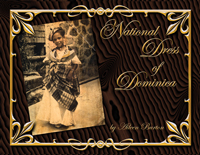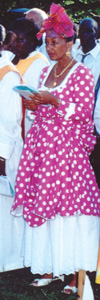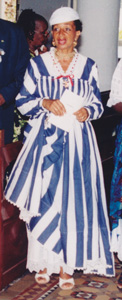 Aileen Burton is the author of National Dress of Dominica published in 2008.
Aileen Burton is the author of National Dress of Dominica published in 2008. More information available at Division of Culture, Old Mill Cultural Centre, Canefield (767) 449-1804.


FROM LEFT: Pink polka dotted dwiyèt with the tête cassée and blue striped dwiyèt with the tête a l'air
Special occasions when the Wòb Dwiyèt was worn
• carrying the brides second bouquet at a Roman Catholic Church wedding
• carrying a baby to be baptised
• Sunday mass and enrolment into various church groups
• at Carnival and other public holidays
• carrying the brides second bouquet at a Roman Catholic Church wedding
• carrying a baby to be baptised
• Sunday mass and enrolment into various church groups
• at Carnival and other public holidays
Cognisant of the fact, various groups and individuals organised events where the Wòb Dwiyèt would be worn.
At the yearly Independence celebrations, there is a Parade of Uniformed Groups. At this event many invited guests, visitors, government officials etc. wear the Wòb Dwiyèt. In the 1980's Prime Minister Dame Mary Eugenia Charles proudly wore this outfit. Mrs Verna Liverpool, wife of the present President Dr. Nicholas Liverpool is resplendent in her Wòb Dwiyèt each year at that event.
It is certain that this splendid Wòb Dwiyèt when worn correctly can hold its own at any formal function in the international arena.
It is a legacy handed down to us through the generations and it is now our responsibility to ensure that this precious gift survives the times and is kept alive in the new millennium for our children, their children and grandchildren.
Events organised for the Wòb Dwiyèt to be worn
• National Queen Show from 1966 for a few years
• National Day celebrations 1967
• The revived custom of carrying the bride’s second bouquet in a Roman Catholic wedding
• Fête Ti Dou Dou (the little ones) from 1997
– organised by the Lions Club of Dominica
• National Day celebrations 1967
– organised by the Premier E.O Leblanc
• The revived custom of carrying the bride’s second bouquet in a Roman Catholic wedding
• Fête Ti Dou Dou (the little ones) from 1997
– organised by the Roseau Cultural Group
• Madame Wòb Dwiyèt Competitions from 1998 for many years
• Miss Wòb Dwiyèt Competition, from 1982
• Traditional Dance Competitions during Independence celebrations (with local government)
• Creole Day, last Friday in October (with Komité Pou Etid Kwéyol)
– organised by Mrs. Vena Mc Dougal
• Miss Wòb Dwiyèt Competition, from 1982
• Traditional Dance Competitions during Independence celebrations (with local government)
• Creole Day, last Friday in October (with Komité Pou Etid Kwéyol)
– organised by the Division of Culture